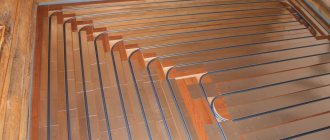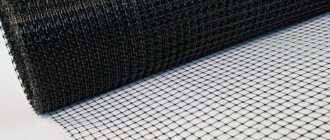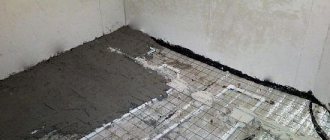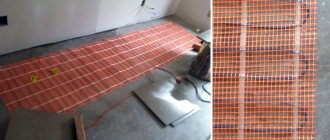Creating a microclimate that is comfortable for residents is one of the most important tasks when arranging housing. To do this, today it is possible to use various methods that have their own advantages and disadvantages. Not long ago, new systems appeared on the market that seem quite promising. Water warm baseboard - a fairly practical way to organize heating of premises, and not only residential ones.
Water warm baseboard
Design and principle of operation of a warm baseboard
We can say that a warm baseboard is a fundamentally new approach to the issue of heating an ordinary apartment or private house. This system received this name due to its visual similarity to the usual baseboard and its compact size. Externally the design is:
- an aluminum box consisting of three walls - top, bottom and front;
- The thickness of the box is no more than 3 cm;
- The height of the front panel ranges from 10 to 24 cm;
- For decorative purposes, the ends of the box are closed with special plugs;
- Inside the box are heating elements that are attached to the wall using mounting brackets.
Depending on the heat source used, a warm baseboard can be electric or water. By the way, outwardly they are practically indistinguishable. The operating principle of a warm baseboard differs significantly from the operating principle of conventional heating devices - convectors or heating radiators.
Anyone who is more deeply interested in economical ways to heat their home knows that the same batteries heat the room by convection. That is, the heat emanating from their surface heats the air. In this case, hot air rises up to the ceiling, where a thermal cushion is created, which displaces cold masses down. In rooms with low ceilings, this difference is not very noticeable and, in principle, comfortable conditions are created. But in rooms with high ceilings it is necessary to use forced ventilation, which will help mix air masses of different temperatures and warm them up as quickly as possible. In this case, most often in the corners of the room the air will still remain cold. Thus, warming up the entire volume of air in a room requires higher temperatures and longer times. Heat loss is 20-30%.
Surely, when using electric oil convectors, you noticed that next to the heater you feel warm, even hot, but literally a meter away from it the air is cold. In addition, the air becomes dry and foreign odors can often be detected.
The operation of a warm baseboard is based on gradual, uniform heating of adjacent walls and floors. Heating the air by convection uses no more than 30% of the radiated heat. Warming begins from the lower layers of air. The heat then slowly “creeps” up the walls, heating their surface in the process. Thanks to this, it became possible to achieve the same temperature throughout the entire height of the room.
A person begins to receive heat from the surface of the walls, which, after heating to a given temperature, literally radiate it.
This method of heating a home has been used in very ancient times. At that time, a system of cavities was specially provided in the walls of houses through which hot steam was supplied. It is also noteworthy that, rising along the walls, the hot air practically does not mix with the surrounding air, thus creating a thermal curtain. This is especially true when heating rooms with panoramic windows.
Cold air leaking through unsealed joints is simply cut off and does not cool the room. Heat loss when using warm baseboards is only 5%. Needless to say, this method is economically beneficial? It has been proven that when walls are heated to a temperature of 37-38°C, a person becomes warm and comfortable even though the air temperature in the room is 16-17°C. A warm baseboard can be used as a complete heating system. Then you need to install it around the entire perimeter of the room. It can also be used as an additional source of heat in places where installing conventional radiators is impossible. For example, for heating a loggia with French glazing.
Then the baseboard should be placed along the double-glazed windows.
Many people are interested in the question : is it advisable to place a plinth around the entire perimeter of the room if there are large-sized furniture along some walls? Considering the principle of its operation and the fact that the rising heat is more aimed at warming the walls, rather than the surrounding air and adjacent objects, we can say that the furniture will not interfere with the full operation of the system. In addition, heating elements have a low-temperature operating mode. They do not heat up above 60°C and cannot harm furniture or any type of floor covering. Thus, we can conclude that a warm baseboard is a safe and economical source of heat.
Electric warm baseboard
Electric models of warm baseboards are more popular than water ones. This is due to a simpler installation method and the fact that electricity is available even in remote areas. The principle of operation of an electric heated baseboard is similar to the principle of operation of the “warm floor” system. Let's take a closer look at the design:
- Inside the box you can see two copper tubes with a diameter of 13 mm and a wall thickness of 1.5 mm. The tubes are tightly fitted onto brass ribs. The bottom tube houses a low-temperature dry heating element;
- Inside the top tube is a heat-resistant silicone insulated electrical cable that provides power to the heater;
- Copper is an excellent heat conductor. The front panel of the plinth is made of aluminum, which is also a good conductor. By combining these two alloys, it became possible to achieve maximum heat transfer;
- Additionally, the system is equipped with a thermostat and temperature sensor . It was with the help of a thermostat that it became possible to achieve significant savings. Manufacturers offer models of different prices, respectively, with different capabilities. There are thermostats that allow you to set the desired temperature several days in advance. Simpler models require constant manual adjustment.
It cannot be said unequivocally that some models are better than others. The choice should be based on your financial capabilities and whether you are willing to constantly adjust the sensor manually. The thermostat is connected to a temperature sensor, which controls the operation of the entire system. To achieve the most correct indicators, the sensor should be placed at a height of 130-150 cm from the floor level. When the temperature in the room reaches the set point, the thermostat will turn off. And it will turn on again when the temperature drops to the lower set temperature.
The length of one module of an electric warm baseboard can be from 0.7 to 2.5 m. This makes it possible to dial a heating circuit of varying power depending on the size of the room. On average, 1 linear meter of baseboard produces from 180 to 280 W of heat. In order for the operation of the electric baseboard to be safe, it should be used only if there is powerful, new electrical wiring. Manufacturers claim that you can simply plug the baseboard into an outlet. But for reliability, it is still recommended to install a separate line that will go directly to the meter and install a separate machine on it.
Water warm baseboard
The operating principle of water models is similar to the operation of water boilers. design differs significantly from electric ones:
- The water baseboard does not have heating elements. It involves the use of already heated coolant. Its role can be either ordinary water or antifreeze;
- The heated liquid flows through cross-linked polyethylene tubes located inside the box;
- There are two tubes inside, located one above the other. In this case, coolant is supplied through the upper tube, and it is taken in through the lower tube;
Sufficient pressure is required to circulate fluid through the system. Therefore, circulation pumps are used to organize water heating in private homes. With their help, coolant under a certain pressure passes through the distribution manifold and is supplied through tubes to the heating modules.
The water modules are connected to each other using special tubes made of cross-linked polyethylene. If the connection point is at a corner, then use polyethylene or corrugated corner joints. The latter are usually made of steel or copper. It is worth noting that for proper operation of water circuits, their length should not exceed 12.5 meters. Some manufacturers allow a length of up to 15 m. If this length is not enough to heat the entire room, it is recommended to equip two separate heating circuits.
The room temperature when using a warm water baseboard can be adjusted either manually on the distribution manifold, or, as in the previous version, using room thermostats. They, in turn, control the servos of the distribution system valves.
As you can see, organizing a water heating system requires much more expense than an electric one. In addition to installing the pump and collector, it is necessary to ensure proper storage conditions for the coolant and its cleaning. This is why electric models are often preferred.
As for connecting a warm baseboard within an ordinary city apartment . It is possible to connect the baseboard to the central heating network. In this case, the danger is the temperature of the coolant and water hammer, which are often present when starting the system. The water temperature in the batteries is 85-90 degrees, and its pressure can reach 9 atmospheres or more. These indicators can have a detrimental effect on the design of a warm baseboard.
Our task is to minimize their impact by physically separating the internal heating circuit from the centralized network.
- This can be done realistically using heat exchangers. That is, devices that, with the help of heat-conducting plates, will take on excess heat from the coolant of the centralized network and transfer the required amount to an internal independent circuit.
- In typical dwellings, riser wiring is used. In this case, each room can have one or two pipe risers. In this case, the water baseboard is directly connected using copper fittings by soldering or plastic pipes complete with fittings. In this way, restrictions on the temperature and pressure of the coolant are removed.
- Thermal valves are installed at the connection points to the riser.
Mounting Tools
When installing a hot water baseboard with your own hands, you need to have the following tools:
- set of adjustable wrenches;
- impact drill or hammer drill;
- scissors for cutting plastic pipes;
- hammer;
- wire cutters;
- pliers.
You may also be interested in an article about electric baseboard heating convectors. Read an informative article about water heated floors for apartments here.
Warm baseboard: advantages and disadvantages
Let's summarize all of the above and highlight the undeniable advantages of using the warm baseboard system:
- Due to the fact that the heat from the baseboard rises up along the walls, warming them up well, you can solve the problem of mold and various fungal microorganisms once and for all. After all, dry walls are one of the key aspects affecting the indoor microclimate;
- Heating of the room occurs evenly and simultaneously along its entire perimeter. There is no need to wait for the heat from the carrier to spread throughout the room, as is the case with the use of heating radiators;
- The ability to achieve uniform temperature throughout the entire height of the room. In this case, cold zones will not form. Many manufacturers claim that the temperature difference between the ceiling and the floor itself can reach no more than a couple of degrees. It is necessary to understand that these indicators can only be achieved under ideal conditions. An important role is played by the thermal insulation of the room itself and its heat loss;
- Heating occurs using the radiation method, which is the most beneficial for the human body. It is perceived in a similar way to solar heat;
- The heat loss of the system itself is no more than 5%, and heating the air in the room using the convection method takes no more than 30% of the heat generated;
- Warm baseboard is compatible with any type of floor covering;
- Thanks to the moderate temperature of the baseboard itself, you don’t have to worry about the nearby furniture drying out;
- The aesthetic appearance of the room, not spoiled by oversized heating radiators. And thanks to the variety of color solutions, you can choose a warm baseboard to suit any interior and make it almost invisible;
- Thanks to its miniature size, using a warm baseboard you can heat rooms in which it is simply impossible to install radiators;
- Thanks to the presence of temperature sensors and thermostats, it is possible to adjust the temperature in a short period of time. And when using more modern thermostat models, the system will maintain comfortable conditions almost without your participation;
- It is thanks to thermostats that the use of warm baseboards is economically beneficial. In addition, the amount of energy consumed will be several times lower than when using other converter-type electric heaters;
The disadvantages include:
- Tangible cost of the system;
- Due to the small distribution in some small cities, purchasing a warm baseboard can be problematic;
- Although the system body is well protected from moisture, it is still not recommended to use warm baseboards in rooms with high humidity. An exception may be special models designed for use in such conditions;
- Limitation of the maximum possible length of the contour of the warm water baseboard. This fact is really worth paying attention to, because the functioning of the system depends on it.
Standard indicators
The standard installation, which is manufactured in a factory, has a power of 240 watts. This is the optimal indicator for a room whose perimeter is approximately twenty meters (taking into account the average ceiling height).
Frequently asked questions concern the possibility of making such a radiator yourself. In principle, it makes sense to do this yourself, but you need to be prepared for the fact that the process will take a lot of time, effort and finances. In some cases, such an experiment turns out to be more expensive than buying a ready-made warm baseboard.
Calculation of the required number of skirting boards
We have already seen that the warm baseboard system is a very successful solution for heating not only an ordinary apartment, but also private houses. Now let's try to understand the issue that will be of interest to those who really decide to purchase this equipment. For more correct calculations, it is necessary to take into account the heat loss of the room. This is influenced by the type of glazing, the number of window openings, whether there is an end room or not, the thickness of the walls and their covering, and much more.
You should also build on generally accepted standards, which state that for heating 1 sq.m. A living room needs 60-100 W of heat. These figures are relevant for residents of the middle climate zone. For more northern regions, 150-200 W of heat will be required.
Now you need to multiply the area of the room by the average, for example 12 m2 × 150 W = 1800 W. To this indicator you need to add a small margin, but without fanaticism.
How to calculate the length of a water heating element
The choice of dyne is primarily influenced by the thermal pressure of the system. Please note that warm baseboards refer to systems that do not operate at high temperatures. And the difference between the temperature of the supply coolant and the return one is no more than 5°C. Thermal pressure can be calculated using the formula
∆T = ((tп+to)/2)-tв, where
- tп – temperature of the supply coolant;
- tо – return medium temperature;
- tв – room air temperature.
It follows that to maintain a room temperature of 20°C and a coolant temperature of 70°C, we have a thermal pressure that is equal to ((70+65)/2)-20 = 47.5°C.
Now, thanks to the data given in the table, you can see how much heat will be generated by 1 linear meter of warm water baseboard. For a value of 47.5°C it is equal to 218 W. To heat a room of 12 m2, which requires 1800 W of heat, you need 1800/218 = 8.25 meters of baseboard. The indicator can be rounded up or down at your discretion.
How to calculate the required length of an electric warm baseboard
In this case, everything is much simpler. You can calculate the required amount to heat a room of any size based on average statistics, as in the example above. Next, look carefully at the packaging, which will always indicate the heat transfer value per linear meter of the product. The number of meters is determined by dividing the required amount of heat per room by this value. For example, to heat a room of 12 m2, which requires 1800 W of heat, you need 1800/190 = 9.47 meters of baseboard. The indicator 190 is taken conditionally.
Operating principle of baseboard heating
Baseboard heating is quite effective due to the fact that it is not the air that is heated, but the walls of the room. The walls here act as radiators that maintain the temperature in the room. To ensure that air flows normally to the baseboard coolant and leaves it unhindered, special two slots are provided in the boxes.
For baseboard heating, the main thing is materials that must have high thermal conductivity. Heating the coolant to very high temperatures is not so important here.
It should be noted that this system can operate as a device that lowers the room temperature. It is enough just to fill the system with special coolant. The effect of such an application will be significantly lower than with heating, but quite noticeable.
The advantages of this system should be noted:
- complete absence of convection, which means no suspended dust in the air;
- baseboard heating is absolutely safe for humans;
- heat spreads evenly throughout the room;
- boxes and walls have a temperature safe for animals and humans;
- dry walls and air;
- amazing ease of installation;
- absence of any contraindications for use;
- baseboard radiators look quite aesthetically pleasing and also save space;
- significant fuel savings;
- ease of dismantling and repair;
- possibility of installing thermostats.
- high price of components - aluminum and copper;
- You won’t be able to make proper baseboard heating with your own hands;
- the most permissible length of the heating circuit should definitely not be more than 15 meters;
- the impossibility of any decoration of the baseboard;
- impossibility of installation close to furniture walls;
- placing heating elements very close to the wall leads to rapid destruction of the wall covering.
In today's conditions, when the materials used in finishing and construction help to reduce all heat loss to a minimum, and the installation of double-glazed windows limits the access of air into the room, baseboard-type heating has become quite relevant.
Video “Plinth heating”:
Do-it-yourself installation of warm baseboards
In addition to the high cost of the system itself, you will also have to pay a significant amount for its installation. In this case, the calculation is made for each linear meter. Based on this, many people have a question: is it possible to install a warm baseboard system yourself? We can say that if you have the skills to work with electrical wiring and plastic pipes, as well as due attention and legibility, this is not so difficult to do.
Self-installation of warm water baseboard
To carry out the work you will need the following materials:
- Metal-plastic pipes;
- Thermal insulation material;
- A collector equipped with taps;
- Metal and plastic adapters;
- Set of tools.
Installation should begin with the installation of the collector. It is necessary to connect a pipe to it, which will provide its power. A boiler running on any type of fuel can be used as a source of coolant. The only condition is that for the system to operate correctly, it is necessary to provide a pressure of at least 3 atm. After you calculate the required length of the plinth according to the recommendations from point 6, you can begin laying the pipes.
- It must be remembered that the maximum length of the circuit should not exceed 12.5 or 15 m, depending on the manufacturer. And that there should be two pipes in the system - one for supply, the other for coolant intake;
- It is also important not to forget about thermal insulation to reduce heat loss. To do this, you need to lay special material around the perimeter of the room between the wall and the pipes;
- Now you need to screw the base to which the heat exchangers will be attached. The plank is secured using self-tapping screws. Please note that the finished baseboard should not lie flush to the floor. Leave a gap of about 1 cm to prevent the device from overheating;
- Now secure the modules and connect them together using crimp fittings;
- When the structure is assembled, you need to connect it to the common highway by installing a collector;
- Before final assembly, be sure to check the system for leaks. To do this, a test run is performed, which will also show the correct operation;
- If the system works reliably, secure the front panel to the baseboard. This is very easy to do, following the recommendations in the instructions.
Self-installation of electric heated baseboard
Installing an electric baseboard requires completely different skills and attention to slightly different factors. It is recommended to connect the system directly to the panel and equip it with a separate circuit breaker. How many circuits there will be in your apartment or house, there should be as many separate lines. Choose wires with a large cross-section that can definitely withstand the load (at least 2.5 mm). Do not forget about the need to connect a thermostat for each circuit and a temperature sensor for each room. This will help set the most optimal temperature for each room.
- The installation should begin with the laying of thermal insulation material;
- Then screw the base of the plinth;
- Attach heat exchangers to it;
- Make a parallel connection of wires;
- Carry out a thorough visual inspection to ensure there are no uninsulated areas;
- Close the structure with the front panel;
- Connect the heating circuit to the thermostat and connect it to the distribution panel;
- Perform a test run of the system.
The gap from the floor to the baseboard should be at least 1 cm, and the distance from the wall at least 1.5 cm. This will ensure proper convection and protect the system from overheating.
Manufacturers and pricing policy
Based on feedback from consumers who have already appreciated all the benefits of warm baseboards and the quality of the product itself, we have identified several trusted manufacturers:
- Among the domestic ones, we can highlight warm skirting boards (“Mr. Tectum”). This is one of the most popular manufacturers. The modules of this company have a depth of 3 cm, a height of 14.5 cm and a length of 2.5 meters. The kit is complete - heating element, front, bottom and top panels, clamps and even thermal insulation material. One module produces 500 W of heat and can heat up to a temperature of 65°C. These skirting boards consist of two copper pipes and brass plates. The front panel is made of aluminum. The price per linear meter is about 3800 rubles.
- "Rehau" is a fairly popular manufacturer of heated floors, which also produces heated skirting boards. A characteristic and distinctive feature of this company’s products is the use of flexible polyethylene pipes. Such pipes do not corrode or fray at bend points. Electric models are distinguished by their small thickness, which significantly expands the possibilities of their application. The average cost per linear meter is 9,800 rubles. but for this money you will get a really high-quality and reliable heating system;
- Austrian can also offer a high-quality and reliable system. The company uses many innovations and constantly improves its products. This allows you to significantly increase the efficiency of the warm baseboard. The cost of their products per meter is 7,000 rubles.
As you can see, the price range allows you to choose a model depending on your financial capabilities. Just before purchasing, be sure to read reviews from real customers.
The article was written for the site.
Tags:Heating radiator, Electricity
Baseboard heating is comfortable, beautiful, economical
A radiator heating system and heated floors are not the only way to heat a room. Recently, warm baseboards have become increasingly popular. This type of heating appeared on our market only a few years ago and there is not much experience in its operation yet. However, it is quickly gaining popularity - it is the most discreet and very comfortable type of heating.
Warm baseboard - small heaters located along the floor around the perimeter of the room. They are named so because of their location and size: the thickness of such a heater is 2.5-3 cm, which is comparable to the size of a standard floor plinth. The height is greater: 12-15 cm, but everything looks organic
What is important: such a system does not limit the installation location of furniture and decorative items, since heat is transferred not by convection, but by radiation
This is what baseboard heating looks like. No more other heating devices











